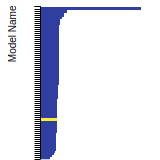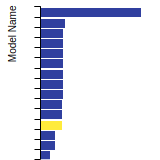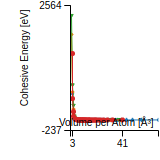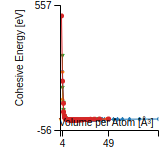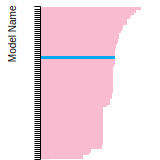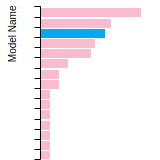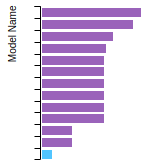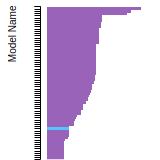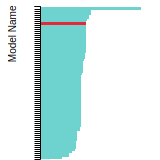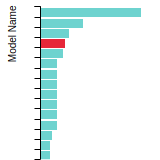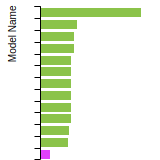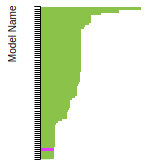 EAM_Dynamo_MendelevHanSon_2007_VFe__MO_249706810527_005
EAM_Dynamo_MendelevHanSon_2007_VFe__MO_249706810527_005
| Title
A single sentence description.
|
Finnis-Sinclair potential (LAMMPS cubic hermite tabulation) for the V-Fe system developed by Mendelev et al. (2007) v005 |
|---|---|
| Description
A short description of the Model describing its key features including for example: type of model (pair potential, 3-body potential, EAM, etc.), modeled species (Ac, Ag, ..., Zr), intended purpose, origin, and so on.
|
We introduced an electronic structure embedding approach to improve the description of the point defects in first-principles calculations, by including the semicore electrons in some V atoms (those near the interstitial where the semicore levels are broadened) but not those further from the point defect. This enables us to combine good accuracy for the defect within large supercells and to expand the data set of first-principles point defect calculations in vanadium with and without small amounts of iron. Based on these data, previous first-principles work, and new calculations on the alloy liquid, we fitted an interatomic potential for the V-Fe system which describes the important configurations likely to arise when such alloys are exposed to radiation. This potential is in a form suitable for molecular dynamics (MD) simulations of large systems. Using the potential, we have calculated the migration barriers of vacancies in the presence of iron, showing that these are broadly similar. On the other hand, MD simulations show that V self-diffusion at high temperatures and Fe diffusion are greatly enhanced by the presence of interstitials. |
| Species
The supported atomic species.
| Fe, V |
| Disclaimer
A statement of applicability provided by the contributor, informing users of the intended use of this KIM Item.
|
The potential was developed to simulate radiation damage in V with small additions of Fe. |
| Content Origin | http://www.ctcms.nist.gov/potentials/Fe.html |
| Contributor |
Mikhail I. Mendelev |
| Maintainer |
Mikhail I. Mendelev |
| Developer |
Won-Joon Sun Mikhail I. Mendelev Seungwu Han Graeme J. Ackland David J. Srolovitz |
| Published on KIM | 2018 |
| How to Cite | Click here to download this citation in BibTeX format. |
| Citations
This panel presents information regarding the papers that have cited the interatomic potential (IP) whose page you are on. The OpenKIM machine learning based Deep Citation framework is used to determine whether the citing article actually used the IP in computations (denoted by "USED") or only provides it as a background citation (denoted by "NOT USED"). For more details on Deep Citation and how to work with this panel, click the documentation link at the top of the panel. The word cloud to the right is generated from the abstracts of IP principle source(s) (given below in "How to Cite") and the citing articles that were determined to have used the IP in order to provide users with a quick sense of the types of physical phenomena to which this IP is applied. The bar chart shows the number of articles that cited the IP per year. Each bar is divided into green (articles that USED the IP) and blue (articles that did NOT USE the IP). Users are encouraged to correct Deep Citation errors in determination by clicking the speech icon next to a citing article and providing updated information. This will be integrated into the next Deep Citation learning cycle, which occurs on a regular basis. OpenKIM acknowledges the support of the Allen Institute for AI through the Semantic Scholar project for providing citation information and full text of articles when available, which are used to train the Deep Citation ML algorithm. |
This panel provides information on past usage of this interatomic potential (IP) powered by the OpenKIM Deep Citation framework. The word cloud indicates typical applications of the potential. The bar chart shows citations per year of this IP (bars are divided into articles that used the IP (green) and those that did not (blue)). The complete list of articles that cited this IP is provided below along with the Deep Citation determination on usage. See the Deep Citation documentation for more information. 
55 Citations (43 used)
Help us to determine which of the papers that cite this potential actually used it to perform calculations. If you know, click the .
USED (high confidence) B. Waters, D. S. Karls, I. Nikiforov, R. Elliott, E. Tadmor, and B. Runnels, “Automated determination of grain boundary energy and potential-dependence using the OpenKIM framework,” Computational Materials Science. 2022. link Times cited: 5 USED (high confidence) K. Zolnikov, D. Kryzhevich, and A. Korchuganov, “Regularities of Structural Rearrangements in Single- and Bicrystals Near the Contact Zone,” Springer Tracts in Mechanical Engineering. 2020. link Times cited: 0 USED (high confidence) D. Xu, Z. Wang, T.-Y. Chang, and F. Chen, “Inverted core–shell potential energy landscape of icosahedral clusters in deeply undercooled metallic liquids and glasses and its effect on the glass forming ability of bcc and fcc metals,” Journal of Physics: Condensed Matter. 2020. link Times cited: 6 Abstract: Current understanding of the origin of icosahedral clusters … read more USED (high confidence) D. Xu, Z. Wang, J. S. Saini, and F. Chen, “Anomalous self-diffusion, structural and energy relaxations and temporal scaling laws in pure tantalum and pure vanadium metallic glasses,” Journal of Applied Physics. 2019. link Times cited: 1 Abstract: While most studies have considered diffusion in metallic gla… read more USED (high confidence) K. Zolnikov, D. Kryzhevich, and A. Korchuganov, “Structural Transformations in the Grain Boundary Region of Nanocrystalline Metals Under Mechanical Loading,” Russian Physics Journal. 2019. link Times cited: 10 USED (high confidence) M. Zhang et al., “MD Simulations and first principles to evaluate the role of binary Fe–V alloys layer on the radiation resistance in the alpha-iron,” Molecular Simulation. 2018. link Times cited: 2 Abstract: ABSTRACT Radiation damage in reactor materials caused by the… read more USED (high confidence) D. Xu and F. Chen, “Continuously variable atomic structure in monatomic metallic glasses through active icosahedral dynamics below glass transition temperature,” Journal of Applied Physics. 2018. link Times cited: 7 Abstract: As a ubiquitous structural feature in metallic glasses, icos… read more USED (high confidence) X. Zhu, C. Wang, N. Hu, W. Hu, W. Duan, and L. Yang, “Irradiation damage of helium-accumulated vanadium: atomic simulations,” RSC Advances. 2016. link Times cited: 2 Abstract: Molecular dynamics simulations have been implemented to gain… read more USED (high confidence) A. Ojha, H. Sehitoglu, L. Patriarca, and H. Maier, “Twin migration in Fe-based bcc crystals: theory and experiments,” Philosophical Magazine. 2014. link Times cited: 33 Abstract: We establish an overall energy expression to determine the t… read more USED (low confidence) S. Yazdani, M. Mesbah, and V. Vitry, “Molecular Dynamics Simulation of the Interaction between Dislocations and Iron–Vanadium Precipitates in Alpha Iron: Effect of Chemical Composition,” Crystals. 2023. link Times cited: 2 Abstract: In this study, molecular dynamics simulations were employed … read more USED (low confidence) X. Hu, L. Yang, X. Wei, H. Wang, and G. Fu, “Molecular Dynamics Simulation on Nanoindentation of M50 Bearing Steel,” Materials. 2023. link Times cited: 0 Abstract: M50 bearing steel has great potential for applications in th… read more USED (low confidence) X. Li, W. Zhang, and L. Miao, “Research on diffusion wear mechanism of WC tool cutting Al2024 based on MD,” The International Journal of Advanced Manufacturing Technology. 2023. link Times cited: 0 USED (low confidence) D. Kryzhevich, A. Korchuganov, and K. Zolnikov, “Role of excess atomic volume in crack growth in bcc iron,” Results in Physics. 2022. link Times cited: 0 USED (low confidence) X. Zhang, Y. Deng, J. Chen, and W. Hu, “Study on the effect of non-centrosymmetric orientation in shocked and ramp compressed α iron,” Materials Today Communications. 2021. link Times cited: 1 USED (low confidence) D. Kryzhevich, A. Korchuganov, and K. Zolnikov, “Effect of Excess Atomic Volume on Crack Evolution in a Deformed Iron Single Crystal,” Materials. 2021. link Times cited: 1 Abstract: This paper presents a molecular dynamics study of how the lo… read more USED (low confidence) W. Choi et al., “Computational design of V-CoCrFeMnNi high-entropy alloys: An atomistic simulation study,” Calphad-computer Coupling of Phase Diagrams and Thermochemistry. 2021. link Times cited: 12 USED (low confidence) H. Chen 陈 et al., “Modification of short-range repulsive interactions in ReaxFF reactive force field for Fe–Ni–Al alloy,” Chinese Physics B. 2021. link Times cited: 1 Abstract: The short-range repulsive interactions of any force field mu… read more USED (low confidence) K. Krylova, I. Lobzenko, A. Semenov, A. Kudreyko, and S. Dmitriev, “Spherically localized discrete breathers in bcc metals V and Nb,” Computational Materials Science. 2020. link Times cited: 22 USED (low confidence) D. S. Kryzhevich, K. Zolnikov, and A. Korchuganov, “Peculiarities of grain boundary migration in vanadium crystal under shear loading,” Journal of Physics: Conference Series. 2019. link Times cited: 0 Abstract: The atomic mechanisms of migration of the symmetric tilt gra… read more USED (low confidence) Y. Wang, J. Ding, S. Huang, J. Zhao, and Y. Wang, “Mesoscale modeling of irradiation damage evolution in bcc iron and vanadium: A comparative study,” Fusion Engineering and Design. 2018. link Times cited: 7 USED (low confidence) A. Korchuganov, D. S. Kryzhevich, and K. Zolnikov, “Features of plasticity nucleation in deformed vanadium crystallite under irradiation,” Journal of Physics: Conference Series. 2018. link Times cited: 0 Abstract: Molecular dynamics simulation of the defect structure nuclea… read more USED (low confidence) J. Li, W.-qing Meng, K. Dong, X.-ming Zhang, and W. Zhao, “Numerical Analysis of Solid-Liquid Two-Phase Abrasive Flow in Microcutting Polycrystalline Materials Based on Molecular Dynamics,” International Journal of Precision Engineering and Manufacturing. 2018. link Times cited: 14 USED (low confidence) D. Kryzhevich, K. Zolnikov, and A. Korchuganov, “PECULIARITIES OF PLASTIC DEFORMATION NUCLEATION IN NANOCRYSTALLINE VANADIUM UNDER SHEAR LOADING,” Perspektivnye materialy s ierarkhicheskoy strukturoy dlya novykh tekhnologiy i nadezhnykh konstruktsiy» i «Khimiya nefti i gaza» v ramkakh Mezhdunarodnogo simpoziuma «Ierarkhicheskie materialy: razrabotka i prilozheniya dlya novykh tekhnologiy i nadezhnykh konstruktsiy. 2018. link Times cited: 0 USED (low confidence) J. Li, W.-qing Meng, K. Dong, X.-M. Zhang, and W. Zhao, “Numerical Analysis of Solid-Liquid Two-Phase Abrasive Flow in Microcutting Polycrystalline Materials Based on Molecular Dynamics,” International Journal of Precision Engineering and Manufacturing. 2018. link Times cited: 1 USED (low confidence) D. Kryzhevich, K. Zolnikov, and A. Korchuganov, “Atomic rearrangements at migration of symmetric tilt grain boundaries in vanadium,” Computational Materials Science. 2018. link Times cited: 28 USED (low confidence) A. Kohnert, M. Cusentino, and B. Wirth, “Molecular statics calculations of the biases and point defect capture volumes of small cavities,” Journal of Nuclear Materials. 2018. link Times cited: 16 USED (low confidence) A. Boev, D. Aksyonov, A. Kartamyshev, V. Maksimenko, I. Nelasov, and A. Lipnitskii, “Interaction of Ti and Cr atoms with point defects in bcc vanadium: A DFT study,” Journal of Nuclear Materials. 2017. link Times cited: 23 USED (low confidence) J. Fu, X. Li, B. Johansson, and J. Zhao, “Improved Finnis-Sinclair potential for vanadium-rich V–Ti–Cr ternary alloys,” Journal of Alloys and Compounds. 2017. link Times cited: 13 USED (low confidence) Y. Wu, R.-B. Li, J. Xiao, and Y. Jiang, “Crystallization in Supercooled BCC-Vanadium, HCP-Zinc and FCC-Aluminum.” 2015. link Times cited: 0 USED (low confidence) R. Murzaev, A. Kistanov, V. Dubinko, D. Terentyev, and S. Dmitriev, “Moving discrete breathers in bcc metals V, Fe and W,” Computational Materials Science. 2015. link Times cited: 43 USED (low confidence) H. Zhang et al., “Enhanced radiation tolerance of nanochannel V films through defects release,” Nuclear Instruments & Methods in Physics Research Section B-beam Interactions With Materials and Atoms. 2014. link Times cited: 17 USED (low confidence) C. Zhang, P. Zhang, R. Li, J. Zhao, and C. Dong, “Stability and migration of vacancy in V-4Cr-4Ti alloy: Effects of Al, Si, Y trace elements,” Journal of Nuclear Materials. 2013. link Times cited: 17 USED (low confidence) M. Rajagopalan, M. Tschopp, and K. Solanki, “Grain Boundary Segregation of Interstitial and Substitutional Impurity Atoms in Alpha-Iron,” JOM. 2013. link Times cited: 81 USED (low confidence) H. Xu, Y. Osetsky, and R. Stoller, “Cascade annealing simulations of bcc iron using object kinetic Monte Carlo,” Journal of Nuclear Materials. 2012. link Times cited: 34 USED (low confidence) X.-Y. Liu, R. Hoagland, M. Demkowicz, M. Nastasi, and A. Misra, “The Influence of Lattice Misfit on the Atomic Structures and Defect Energetics of Face Centered Cubic–Body Centered Cubic Interfaces,” Journal of Engineering Materials and Technology-transactions of The Asme. 2012. link Times cited: 9 Abstract: Using “tunable” interatomic potentials, the lattice misfits … read more USED (low confidence) D. E. Smirnova, S. Starikov, S. Starikov, V. Stegailov, and V. Stegailov, “Interatomic potential for uranium in a wide range of pressures and temperatures,” Journal of Physics: Condensed Matter. 2012. link Times cited: 3 Abstract: Using the force-matching method we develop an interatomic po… read more USED (low confidence) N. Oono, N. Nita, Y. Abe, Y. Satoh, and H. Matsui, “Effects of iron concentration on the microstructure of V–Fe alloys after low-dose neutron irradiation,” Journal of Nuclear Materials. 2011. link Times cited: 4 USED (low confidence) S.-G. Kim et al., “Semi-Empirical Potential Methods for Atomistic Simulations of Metals and Their Construction Procedures,” Journal of Engineering Materials and Technology-transactions of The Asme. 2009. link Times cited: 20 Abstract: General theory of semi-empirical potential methods including… read more USED (low confidence) M. Mendelev and Y. Mishin, “Molecular dynamics study of self-diffusion in bcc Fe,” Physical Review B. 2009. link Times cited: 99 Abstract: A semiempirical interatomic potential for Fe was used to cal… read more USED (low confidence) O. Chirayutthanasak et al., “Universal function for grain boundary energies in bcc metals,” Scripta Materialia. 2024. link Times cited: 0 USED (low confidence) Y. Zhang, Z. Xiao, and X. Bai, “Effect of Cr Concentration on ½<111> to <100> Dislocation Loop Transformation in Fe-Cr alloys,” Journal of Nuclear Materials. 2021. link Times cited: 10 USED (low confidence) D. S. Kryzhevich, K. Zolnikov, and A. Korchuganov, “Atomic mechanisms of plasticity nucleation in nanocrystalline vanadium.” 2018. link Times cited: 0 USED (low confidence) R. Khanna and V. Sahajwalla, “Atomistic Simulations of Properties and Phenomena at High Temperatures.” 2014. link Times cited: 3 NOT USED (low confidence) Y. Lei et al., “An Embedded-Atom Method Potential for studying the properties of Fe-Pb solid-liquid interface,” Journal of Nuclear Materials. 2022. link Times cited: 1 NOT USED (high confidence) Q. Yang and P. Olsson, “Full energy range primary radiation damage model,” Physical Review Materials. 2021. link Times cited: 9 Abstract: A full energy range primary radiation damage model is presen… read more NOT USED (high confidence) D. Lubyanoi, A. Markidonov, E. Pudov, V. Shakhmanov, E. Kuzin, and O. S. Semenova, “Efficient Technologies for Producing Cast Iron Billets and Products with Specified Properties and Microstructure,” IOP Conference Series: Materials Science and Engineering. 2021. link Times cited: 1 Abstract: The article discusses the use of resonant-pulsating refining… read more NOT USED (high confidence) A. Dutta, N. Gayathri, S. Neogy, and P. Mukherjee, “Microstructural characterisation of proton irradiated niobium using X-ray diffraction technique,” Philosophical Magazine. 2018. link Times cited: 11 Abstract: The microstructural parameters in pure Nb, irradiated with 5… read more NOT USED (high confidence) I. Adlakha and K. Solanki, “Atomic-scale investigation of triple junction role on defects binding energetics and structural stability in α-Fe,” Acta Materialia. 2016. link Times cited: 17 NOT USED (high confidence) Y. Yang, S. Li, X. Ding, J. Sun, and E. Salje, “Interface Driven Pseudo‐Elasticity in a‐Fe Nanowires,” Advanced Functional Materials. 2016. link Times cited: 20 Abstract: Molecular dynamics simulations of bent [100] α‐Fe nanowires … read more NOT USED (high confidence) A. Ojha, H. Sehitoglu, L. Patriarca, and H. Maier, “Twin nucleation in Fe-based bcc alloys—modeling and experiments,” Modelling and Simulation in Materials Science and Engineering. 2014. link Times cited: 43 Abstract: We develop an analytical expression for twin nucleation stre… read more NOT USED (high confidence) M. Mendelev and B. Bokstein, “Molecular dynamics study of self-diffusion in Zr,” Philosophical Magazine. 2010. link Times cited: 56 Abstract: We employed a recently developed semi-empirical Zr potential… read more NOT USED (high confidence) A. T. Raji, S. Scandolo, R. Mazzarello, S. Nsengiyumva, M. Härting, and D. T. Britton, “Ab initio pseudopotential study of vacancies and self-interstitials in hcp titanium,” Philosophical Magazine. 2009. link Times cited: 48 Abstract: By means of an ab initio plane-wave pseudopotential method, … read more NOT USED (high confidence) J. Duan, “Computer modeling of diffusion in Ni-rich Ni3Al and composition dependence of diffusion in γ′ Ni3Al,” Journal of Physics: Condensed Matter. 2008. link Times cited: 7 Abstract: Atomistic simulations of diffusion in off-stoichiometric Ni-… read more NOT USED (high confidence) V. A. Romanov, A. B. Sivak, P. A. Sivak, and V. M. Chernov, “EQUILIBRIUM AND DIFFUSION CHARACTERISTICS OF SELF-POINT DEFECTS IN VANADIUM,” Problems of Atomic Science and Technology, Ser. Thermonuclear Fusion. 2012. link Times cited: 5 Abstract: Ванадий и его жаропрочные малоактивируемые сплавы являются п… read more NOT USED (definite) J. Li, W.-qing Meng, K. Dong, X.-ming Zhang, and W. Zhao, “Study of Effect of Impacting Direction on Abrasive Nanometric Cutting Process with Molecular Dynamics,” Nanoscale Research Letters. 2018. link Times cited: 24 |
| Funding | Not available |
| Short KIM ID
The unique KIM identifier code.
| MO_249706810527_005 |
| Extended KIM ID
The long form of the KIM ID including a human readable prefix (100 characters max), two underscores, and the Short KIM ID. Extended KIM IDs can only contain alpha-numeric characters (letters and digits) and underscores and must begin with a letter.
| EAM_Dynamo_MendelevHanSon_2007_VFe__MO_249706810527_005 |
| DOI |
10.25950/8b792449 https://doi.org/10.25950/8b792449 https://commons.datacite.org/doi.org/10.25950/8b792449 |
| KIM Item Type
Specifies whether this is a Portable Model (software implementation of an interatomic model); Portable Model with parameter file (parameter file to be read in by a Model Driver); Model Driver (software implementation of an interatomic model that reads in parameters).
| Portable Model using Model Driver EAM_Dynamo__MD_120291908751_005 |
| Driver | EAM_Dynamo__MD_120291908751_005 |
| KIM API Version | 2.0 |
| Potential Type | eam |
| Programming Language(s)
The programming languages used in the code and the percentage of the code written in each one. "N/A" means "not applicable" and refers to model parameterizations which only include parameter tables and have no programming language.
| N/A |
| Previous Version | EAM_Dynamo_MendelevHanSon_2007_VFe__MO_249706810527_004 |
| Grade | Name | Category | Brief Description | Full Results | Aux File(s) |
|---|---|---|---|---|---|
| P | vc-species-supported-as-stated | mandatory | The model supports all species it claims to support; see full description. |
Results | Files |
| P | vc-periodicity-support | mandatory | Periodic boundary conditions are handled correctly; see full description. |
Results | Files |
| P | vc-permutation-symmetry | mandatory | Total energy and forces are unchanged when swapping atoms of the same species; see full description. |
Results | Files |
| B | vc-forces-numerical-derivative | consistency | Forces computed by the model agree with numerical derivatives of the energy; see full description. |
Results | Files |
| P | vc-dimer-continuity-c1 | informational | The energy versus separation relation of a pair of atoms is C1 continuous (i.e. the function and its first derivative are continuous); see full description. |
Results | Files |
| P | vc-objectivity | informational | Total energy is unchanged and forces transform correctly under rigid-body translation and rotation; see full description. |
Results | Files |
| P | vc-inversion-symmetry | informational | Total energy is unchanged and forces change sign when inverting a configuration through the origin; see full description. |
Results | Files |
| P | vc-memory-leak | informational | The model code does not have memory leaks (i.e. it releases all allocated memory at the end); see full description. |
Results | Files |
| P | vc-thread-safe | mandatory | The model returns the same energy and forces when computed in serial and when using parallel threads for a set of configurations. Note that this is not a guarantee of thread safety; see full description. |
Results | Files |
| P | vc-unit-conversion | mandatory | The model is able to correctly convert its energy and/or forces to different unit sets; see full description. |
Results | Files |
BCC Lattice Constant
This bar chart plot shows the mono-atomic body-centered cubic (bcc) lattice constant predicted by the current model (shown in the unique color) compared with the predictions for all other models in the OpenKIM Repository that support the species. The vertical bars show the average and standard deviation (one sigma) bounds for all model predictions. Graphs are generated for each species supported by the model.
Cohesive Energy Graph
This graph shows the cohesive energy versus volume-per-atom for the current mode for four mono-atomic cubic phases (body-centered cubic (bcc), face-centered cubic (fcc), simple cubic (sc), and diamond). The curve with the lowest minimum is the ground state of the crystal if stable. (The crystal structure is enforced in these calculations, so the phase may not be stable.) Graphs are generated for each species supported by the model.
Diamond Lattice Constant
This bar chart plot shows the mono-atomic face-centered diamond lattice constant predicted by the current model (shown in the unique color) compared with the predictions for all other models in the OpenKIM Repository that support the species. The vertical bars show the average and standard deviation (one sigma) bounds for all model predictions. Graphs are generated for each species supported by the model.
Dislocation Core Energies
This graph shows the dislocation core energy of a cubic crystal at zero temperature and pressure for a specific set of dislocation core cutoff radii. After obtaining the total energy of the system from conjugate gradient minimizations, non-singular, isotropic and anisotropic elasticity are applied to obtain the dislocation core energy for each of these supercells with different dipole distances. Graphs are generated for each species supported by the model.
(No matching species)FCC Elastic Constants
This bar chart plot shows the mono-atomic face-centered cubic (fcc) elastic constants predicted by the current model (shown in blue) compared with the predictions for all other models in the OpenKIM Repository that support the species. The vertical bars show the average and standard deviation (one sigma) bounds for all model predictions. Graphs are generated for each species supported by the model.
FCC Lattice Constant
This bar chart plot shows the mono-atomic face-centered cubic (fcc) lattice constant predicted by the current model (shown in red) compared with the predictions for all other models in the OpenKIM Repository that support the species. The vertical bars show the average and standard deviation (one sigma) bounds for all model predictions. Graphs are generated for each species supported by the model.
FCC Stacking Fault Energies
This bar chart plot shows the intrinsic and extrinsic stacking fault energies as well as the unstable stacking and unstable twinning energies for face-centered cubic (fcc) predicted by the current model (shown in blue) compared with the predictions for all other models in the OpenKIM Repository that support the species. The vertical bars show the average and standard deviation (one sigma) bounds for all model predictions. Graphs are generated for each species supported by the model.
(No matching species)FCC Surface Energies
This bar chart plot shows the mono-atomic face-centered cubic (fcc) relaxed surface energies predicted by the current model (shown in blue) compared with the predictions for all other models in the OpenKIM Repository that support the species. The vertical bars show the average and standard deviation (one sigma) bounds for all model predictions. Graphs are generated for each species supported by the model.
(No matching species)SC Lattice Constant
This bar chart plot shows the mono-atomic simple cubic (sc) lattice constant predicted by the current model (shown in the unique color) compared with the predictions for all other models in the OpenKIM Repository that support the species. The vertical bars show the average and standard deviation (one sigma) bounds for all model predictions. Graphs are generated for each species supported by the model.
Cubic Crystal Basic Properties Table
Species: FeSpecies: V
Disclaimer From Model Developer
The potential was developed to simulate radiation damage in V with small additions of Fe.
Creators:
Contributor: karls
Publication Year: 2019
DOI: https://doi.org/10.25950/64cb38c5
This Test Driver uses LAMMPS to compute the cohesive energy of a given monoatomic cubic lattice (fcc, bcc, sc, or diamond) at a variety of lattice spacings. The lattice spacings range from a_min (=a_min_frac*a_0) to a_max (=a_max_frac*a_0) where a_0, a_min_frac, and a_max_frac are read from stdin (a_0 is typically approximately equal to the equilibrium lattice constant). The precise scaling and number of lattice spacings sampled between a_min and a_0 (a_0 and a_max) is specified by two additional parameters passed from stdin: N_lower and samplespacing_lower (N_upper and samplespacing_upper). Please see README.txt for further details.
| Test | Test Results | Link to Test Results page | Benchmark time
Usertime multiplied by the Whetstone Benchmark. This number can be used (approximately) to compare the performance of different models independently of the architecture on which the test was run.
Measured in Millions of Whetstone Instructions (MWI) |
|---|---|---|---|
| Cohesive energy versus lattice constant curve for bcc Fe v004 | view | 14143 | |
| Cohesive energy versus lattice constant curve for bcc V v004 | view | 13815 | |
| Cohesive energy versus lattice constant curve for diamond Fe v004 | view | 22699 | |
| Cohesive energy versus lattice constant curve for diamond V v004 | view | 16712 | |
| Cohesive energy versus lattice constant curve for fcc Fe v004 | view | 13964 | |
| Cohesive energy versus lattice constant curve for fcc V v004 | view | 16565 | |
| Cohesive energy versus lattice constant curve for sc Fe v004 | view | 14093 | |
| Cohesive energy versus lattice constant curve for sc V v004 | view | 15755 |
Creators: Junhao Li and Ellad Tadmor
Contributor: tadmor
Publication Year: 2019
DOI: https://doi.org/10.25950/5853fb8f
Computes the cubic elastic constants for some common crystal types (fcc, bcc, sc, diamond) by calculating the hessian of the energy density with respect to strain. An estimate of the error associated with the numerical differentiation performed is reported.
| Test | Test Results | Link to Test Results page | Benchmark time
Usertime multiplied by the Whetstone Benchmark. This number can be used (approximately) to compare the performance of different models independently of the architecture on which the test was run.
Measured in Millions of Whetstone Instructions (MWI) |
|---|---|---|---|
| Elastic constants for bcc Fe at zero temperature v006 | view | 2111 | |
| Elastic constants for bcc V at zero temperature v006 | view | 4127 | |
| Elastic constants for diamond V at zero temperature v001 | view | 7325 | |
| Elastic constants for fcc Fe at zero temperature v006 | view | 6078 | |
| Elastic constants for fcc V at zero temperature v006 | view | 6494 | |
| Elastic constants for sc Fe at zero temperature v006 | view | 3711 | |
| Elastic constants for sc V at zero temperature v006 | view | 2111 |
Creators: Junhao Li
Contributor: jl2922
Publication Year: 2019
DOI: https://doi.org/10.25950/d794c746
Computes the elastic constants for hcp crystals by calculating the hessian of the energy density with respect to strain. An estimate of the error associated with the numerical differentiation performed is reported.
| Test | Test Results | Link to Test Results page | Benchmark time
Usertime multiplied by the Whetstone Benchmark. This number can be used (approximately) to compare the performance of different models independently of the architecture on which the test was run.
Measured in Millions of Whetstone Instructions (MWI) |
|---|---|---|---|
| Elastic constants for hcp Fe at zero temperature v004 | view | 1560 | |
| Elastic constants for hcp V at zero temperature v004 | view | 1560 |
Creators:
Contributor: ilia
Publication Year: 2024
DOI: https://doi.org/10.25950/2f2c4ad3
Computes the equilibrium crystal structure and energy for an arbitrary crystal at zero temperature and applied stress by performing symmetry-constrained relaxation. The crystal structure is specified using the AFLOW prototype designation. Multiple sets of free parameters corresponding to the crystal prototype may be specified as initial guesses for structure optimization. No guarantee is made regarding the stability of computed equilibria, nor that any are the ground state.
| Test | Test Results | Link to Test Results page | Benchmark time
Usertime multiplied by the Whetstone Benchmark. This number can be used (approximately) to compare the performance of different models independently of the architecture on which the test was run.
Measured in Millions of Whetstone Instructions (MWI) |
|---|---|---|---|
| Equilibrium crystal structure and energy for FeV in AFLOW crystal prototype AB3_cP8_223_a_c v002 | view | 107191 | |
| Equilibrium crystal structure and energy for FeV in AFLOW crystal prototype AB_cP2_221_a_b v002 | view | 94087 |
Creators:
Contributor: ilia
Publication Year: 2025
DOI: https://doi.org/10.25950/866c7cfa
Computes the equilibrium crystal structure and energy for an arbitrary crystal at zero temperature and applied stress by performing symmetry-constrained relaxation. The crystal structure is specified using the AFLOW prototype designation. Multiple sets of free parameters corresponding to the crystal prototype may be specified as initial guesses for structure optimization. No guarantee is made regarding the stability of computed equilibria, nor that any are the ground state.
| Test | Test Results | Link to Test Results page | Benchmark time
Usertime multiplied by the Whetstone Benchmark. This number can be used (approximately) to compare the performance of different models independently of the architecture on which the test was run.
Measured in Millions of Whetstone Instructions (MWI) |
|---|---|---|---|
| Equilibrium crystal structure and energy for Fe in AFLOW crystal prototype A_cF4_225_a v003 | view | 485386 | |
| Equilibrium crystal structure and energy for V in AFLOW crystal prototype A_cF4_225_a v003 | view | 188485 | |
| Equilibrium crystal structure and energy for Fe in AFLOW crystal prototype A_cI2_229_a v003 | view | 146249 | |
| Equilibrium crystal structure and energy for V in AFLOW crystal prototype A_cI2_229_a v003 | view | 196092 | |
| Equilibrium crystal structure and energy for Fe in AFLOW crystal prototype A_hP2_194_c v003 | view | 166057 | |
| Equilibrium crystal structure and energy for Fe in AFLOW crystal prototype A_tP28_136_f2ij v003 | view | 560025 |
Creators:
Contributor: brunnels
Publication Year: 2022
DOI: https://doi.org/10.25950/2c59c9d6
Computes grain boundary energy for a range of tilt angles given a crystal structure, tilt axis, and material.
Creators: Daniel S. Karls and Junhao Li
Contributor: karls
Publication Year: 2019
DOI: https://doi.org/10.25950/2765e3bf
Equilibrium lattice constant and cohesive energy of a cubic lattice at zero temperature and pressure.
| Test | Test Results | Link to Test Results page | Benchmark time
Usertime multiplied by the Whetstone Benchmark. This number can be used (approximately) to compare the performance of different models independently of the architecture on which the test was run.
Measured in Millions of Whetstone Instructions (MWI) |
|---|---|---|---|
| Equilibrium zero-temperature lattice constant for bcc Fe v007 | view | 2143 | |
| Equilibrium zero-temperature lattice constant for bcc V v007 | view | 2783 | |
| Equilibrium zero-temperature lattice constant for diamond Fe v007 | view | 3423 | |
| Equilibrium zero-temperature lattice constant for diamond V v007 | view | 4031 | |
| Equilibrium zero-temperature lattice constant for fcc Fe v007 | view | 4095 | |
| Equilibrium zero-temperature lattice constant for fcc V v007 | view | 2655 | |
| Equilibrium zero-temperature lattice constant for sc Fe v007 | view | 2495 | |
| Equilibrium zero-temperature lattice constant for sc V v007 | view | 2591 |
Creators: Daniel S. Karls and Junhao Li
Contributor: karls
Publication Year: 2019
DOI: https://doi.org/10.25950/c339ca32
Calculates lattice constant of hexagonal bulk structures at zero temperature and pressure by using simplex minimization to minimize the potential energy.
| Test | Test Results | Link to Test Results page | Benchmark time
Usertime multiplied by the Whetstone Benchmark. This number can be used (approximately) to compare the performance of different models independently of the architecture on which the test was run.
Measured in Millions of Whetstone Instructions (MWI) |
|---|---|---|---|
| Equilibrium lattice constants for hcp Fe v005 | view | 35306 | |
| Equilibrium lattice constants for hcp V v005 | view | 20057 |
Creators:
Contributor: mjwen
Publication Year: 2024
DOI: https://doi.org/10.25950/9d9822ec
This Test Driver uses LAMMPS to compute the linear thermal expansion coefficient at a finite temperature under a given pressure for a cubic lattice (fcc, bcc, sc, diamond) of a single given species.
| Test | Test Results | Link to Test Results page | Benchmark time
Usertime multiplied by the Whetstone Benchmark. This number can be used (approximately) to compare the performance of different models independently of the architecture on which the test was run.
Measured in Millions of Whetstone Instructions (MWI) |
|---|---|---|---|
| Linear thermal expansion coefficient of bcc Fe at 293.15 K under a pressure of 0 MPa v002 | view | 487147 | |
| Linear thermal expansion coefficient of bcc V at 293.15 K under a pressure of 0 MPa v002 | view | 293592 |
Creators: Matt Bierbaum
Contributor: mattbierbaum
Publication Year: 2019
DOI: https://doi.org/10.25950/6c43a4e6
Calculates the surface energy of several high symmetry surfaces and produces a broken-bond model fit. In latex form, the fit equations are given by:
E_{FCC} (\vec{n}) = p_1 (4 \left( |x+y| + |x-y| + |x+z| + |x-z| + |z+y| +|z-y|\right)) + p_2 (8 \left( |x| + |y| + |z|\right)) + p_3 (2 ( |x+ 2y + z| + |x+2y-z| + |x-2y + z| + |x-2y-z| + |2x+y+z| + |2x+y-z| +|2x-y+z| +|2x-y-z| +|x+y+2z| +|x+y-2z| +|x-y+2z| +|x-y-2z| ) + c
E_{BCC} (\vec{n}) = p_1 (6 \left( | x+y+z| + |x+y-z| + |-x+y-z| + |x-y+z| \right)) + p_2 (8 \left( |x| + |y| + |z|\right)) + p_3 (4 \left( |x+y| + |x-y| + |x+z| + |x-z| + |z+y| +|z-y|\right)) +c.
In Python, these two fits take the following form:
def BrokenBondFCC(params, index):
import numpy
x, y, z = index
x = x / numpy.sqrt(x**2.+y**2.+z**2.)
y = y / numpy.sqrt(x**2.+y**2.+z**2.)
z = z / numpy.sqrt(x**2.+y**2.+z**2.)
return params[0]*4* (abs(x+y) + abs(x-y) + abs(x+z) + abs(x-z) + abs(z+y) + abs(z-y)) + params[1]*8*(abs(x) + abs(y) + abs(z)) + params[2]*(abs(x+2*y+z) + abs(x+2*y-z) +abs(x-2*y+z) +abs(x-2*y-z) + abs(2*x+y+z) +abs(2*x+y-z) +abs(2*x-y+z) +abs(2*x-y-z) + abs(x+y+2*z) +abs(x+y-2*z) +abs(x-y+2*z) +abs(x-y-2*z))+params[3]
def BrokenBondBCC(params, x, y, z):
import numpy
x, y, z = index
x = x / numpy.sqrt(x**2.+y**2.+z**2.)
y = y / numpy.sqrt(x**2.+y**2.+z**2.)
z = z / numpy.sqrt(x**2.+y**2.+z**2.)
return params[0]*6*(abs(x+y+z) + abs(x-y-z) + abs(x-y+z) + abs(x+y-z)) + params[1]*8*(abs(x) + abs(y) + abs(z)) + params[2]*4* (abs(x+y) + abs(x-y) + abs(x+z) + abs(x-z) + abs(z+y) + abs(z-y)) + params[3]
| Test | Test Results | Link to Test Results page | Benchmark time
Usertime multiplied by the Whetstone Benchmark. This number can be used (approximately) to compare the performance of different models independently of the architecture on which the test was run.
Measured in Millions of Whetstone Instructions (MWI) |
|---|---|---|---|
| Broken-bond fit of high-symmetry surface energies in bcc Fe v004 | view | 16282 | |
| Broken-bond fit of high-symmetry surface energies in bcc V v004 | view | 17690 |
Creators:
Contributor: efuem
Publication Year: 2023
DOI: https://doi.org/10.25950/fca89cea
Computes the monovacancy formation energy and relaxation volume for cubic and hcp monoatomic crystals.
| Test | Test Results | Link to Test Results page | Benchmark time
Usertime multiplied by the Whetstone Benchmark. This number can be used (approximately) to compare the performance of different models independently of the architecture on which the test was run.
Measured in Millions of Whetstone Instructions (MWI) |
|---|---|---|---|
| Monovacancy formation energy and relaxation volume for bcc Fe | view | 361403 | |
| Monovacancy formation energy and relaxation volume for bcc V | view | 285574 |
Creators:
Contributor: efuem
Publication Year: 2023
DOI: https://doi.org/10.25950/c27ba3cd
Computes the monovacancy formation and migration energies for cubic and hcp monoatomic crystals.
| Test | Test Results | Link to Test Results page | Benchmark time
Usertime multiplied by the Whetstone Benchmark. This number can be used (approximately) to compare the performance of different models independently of the architecture on which the test was run.
Measured in Millions of Whetstone Instructions (MWI) |
|---|---|---|---|
| Vacancy formation and migration energy for bcc Fe | view | 4356714 | |
| Vacancy formation and migration energy for bcc V | view | 4895910 |
| Test | Error Categories | Link to Error page |
|---|---|---|
| Elastic constants for diamond Fe at zero temperature v001 | other | view |
EquilibriumCrystalStructure__TD_457028483760_003
| Test | Error Categories | Link to Error page |
|---|---|---|
| Equilibrium crystal structure and energy for Fe in AFLOW crystal prototype A_tP1_123_a v003 | other | view |
| EAM_Dynamo_MendelevHanSon_2007_VFe__MO_249706810527_005.txz | Tar+XZ | Linux and OS X archive |
| EAM_Dynamo_MendelevHanSon_2007_VFe__MO_249706810527_005.zip | Zip | Windows archive |
This Model requires a Model Driver. Archives for the Model Driver EAM_Dynamo__MD_120291908751_005 appear below.
| EAM_Dynamo__MD_120291908751_005.txz | Tar+XZ | Linux and OS X archive |
| EAM_Dynamo__MD_120291908751_005.zip | Zip | Windows archive |
